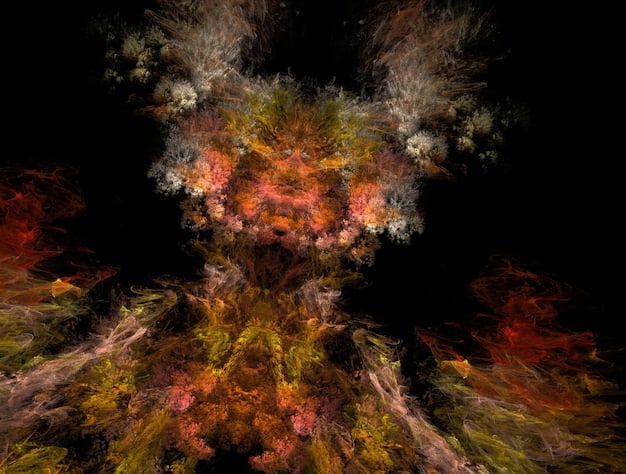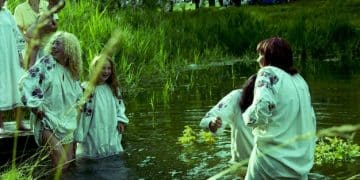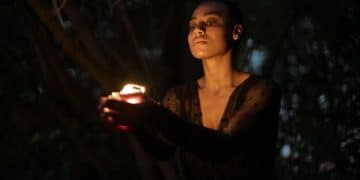The Power of Ritual: Exploring Approaches in Occult Literature

The Power of Ritual: Analyzing Different Approaches to Ritual Magic in Recent Occult Literature reveals a diverse range of practices and beliefs within the occult, exploring how rituals serve as transformative tools, connecting practitioners to deeper spiritual realities and personal empowerment.
Delving into recent occult literature, the power of ritual: analyzing different approaches to ritual magic in recent occult literature showcases the varied and transformative roles rituals play in modern occult practices.
Understanding Ritual Magic in Contemporary Occultism
Ritual magic, a cornerstone of many occult traditions, continues to evolve and adapt in contemporary practice. This section explores the essence of ritual magic, setting the stage for a deeper analysis of its diverse applications.
Defining ritual magic is complex, as it encompasses a broad spectrum of practices. However, at its core, it involves structured actions and symbolic gestures intended to create specific outcomes, whether spiritual, psychological, or material.
The Purpose of Rituals
Rituals serve various purposes within occultism, each tailored to the practitioner’s goals and the specific tradition they follow.
- Spiritual Connection: Many rituals aim to establish contact with deities, spirits, or other higher powers, fostering a sense of connection and divine guidance.
- Personal Transformation: Rituals can be powerful tools for self-improvement, helping individuals overcome limiting beliefs, develop new skills, or heal emotional wounds.
- Manifestation: Some rituals are designed to attract specific outcomes or manifest desired changes in the practitioner’s life or the world around them.
- Protection: Rituals can create energetic shields or invoke protective forces, safeguarding the practitioner from negative influences or harm.
Ultimately, ritual magic is a dynamic and adaptable practice, shaped by the individual’s intent and the specific context in which it is performed. It is a tool for empowerment, transformation, and connection.

In summary, understanding the purpose and intention of ritual magic is crucial before exploring various approaches outlined in the field of occultism. These structured sequences are designed to create tangible results as well as intangible changes.
Ceremonial Magic: Structure and Symbolism
Ceremonial magic represents a highly structured and often complex approach to ritual practice within the occult. This section explores the key characteristics of ceremonial magic and its emphasis on precise symbolism.
Ceremonial magic traditions emphasize elaborate rituals, detailed procedures, and the use of specific tools and symbols. These rituals often draw upon ancient grimoires and esoteric texts, aiming to invoke powerful entities or achieve profound spiritual insights.
Key Elements of Ceremonial Magic
Several elements define ceremonial magic, contributing to its unique character and effectiveness.
- Grimoires and Texts: Ceremonial magic often relies on ancient grimoires, such as the Key of Solomon or the Lesser Key of Solomon, which provide detailed instructions for performing rituals and invoking specific entities.
- Regalia and Tools: Specific tools, such as wands, swords, chalices, and robes, play a crucial role in ceremonial magic, each imbued with symbolic meaning and energetic significance.
- Precise Timing and Alignment: Ceremonial rituals often require precise timing, aligning with specific astrological configurations or lunar phases to maximize their efficacy.
- Invocation and Evocation: Ceremonial magic often involves invoking or evoking specific deities, spirits, or other entities, seeking their guidance, assistance, or knowledge.
In summary, ceremonial magic is a blend of structure, symbolism, and deep-rooted tradition. Its practitioners seek powerful results through highly detailed and energetically focussed rituals.
Chaos Magic: Embracing Flexibility and Individualism
Chaos magic represents a radical departure from traditional forms of ritual practice within occultism. This section delves into the core principles of chaos magic and its emphasis on personal gnosis and results-based experimentation.
Chaos magic is rooted on the belief that belief itself is a tool. Practitioners discard rigid doctrines and embrace a flexible approach to ritual, drawing upon diverse sources and adapting techniques to suit their individual needs and goals.

Core Principles of Chaos Magic:
- Belief as a Tool: Chaos magic practitioners recognize that belief is a powerful force that can be used to shape reality. They consciously adopt and discard belief systems as needed to achieve their desired outcomes.
- Personal Gnosis: Gnosis refers to a state of altered consciousness or heightened awareness achieved through various techniques, such as meditation, sensory overload, or intense emotion. Chaos magicians use gnosis to bypass the conscious mind and directly program the subconscious.
- Sigils and Symbols: Sigils, personalized symbols representing a specific intent, are a central tool in chaos magic. Practitioners create sigils and charge them with their intention through gnosis, launching them into the subconscious to manifest their desired results.
- Results-Based Approach: Chaos magic emphasizes practical results over adherence to dogma. Practitioners evaluate the effectiveness of their rituals based on tangible outcomes, refining their techniques based on their experiences.
Chaos magic is not a rejection of all traditional occult practices but rather a reimagining of how those practices can be adapted and applied in a more flexible and individualistic way. It is an empowering approach for those who seek to harness the power of belief and intention to shape their own reality.
To sum up, the core concepts of chaos magic revolve around the belief that reality and rituals are malleable mental constructs that can be used to achieve various results sought out by the practitioner. This unique system has become a focal point within the occultism community.
Witchcraft Rituals: Nature, Cycles, and Embodiment
Witchcraft, with its deep roots in folklore, folk magic, and reverence for nature, offers a distinct approach to ritual practice. This section explores the key elements of witchcraft rituals, including Sabbats, Esbats, and the emphasis on embodied experience.
Witchcraft rituals generally celebrate the cycles of nature, honoring the changing seasons and the phases of the moon. These rituals often involve working with herbs, stones, and other natural materials, connecting practitioners to the earth’s energy.
Exploring Diverse Practices:
Traditional witchcraft and modern Wicca are a few of the many practices relating to witchcraft rituals.
- Sabbats: Sabbats are major festivals in the Wheel of the Year, marking significant points in the agricultural cycle, such as the solstices and equinoxes.
- Esbats: Esbats are lunar festivals, celebrating the full and new moons.
- Herbalism and Folk Magic: Witchcraft rituals often incorporate herbalism and folk magic, utilizing the power of plants and traditional remedies to achieve desired outcomes.
- Celebration of the Natural World: The beauty of the world and the energies given forth by the natural world are things that witches are able to use in their rituals.
In closing, the history and current impact of witchcraft and nature can be felt throughout the occultism community. Working with nature and its cycles has been the focal point of witchcraft since its early existence.
Thelemic Rituals: Will, Law, and Cosmic Connection
Thelema, a philosophical and occult system developed by Aleister Crowley, offers a unique perspective on ritual practice. This section explores the core concepts of Thelemic rituals, including the Law of Thelema, the concept of True Will, and the emphasis on achieving cosmic connection.
Thelemic rituals aim to assist the practitioner in discovering and following their True Will – their unique purpose and destiny in life – aligning them with the cosmic forces.
A Look Into the History:
Thelema and Aleister Crowley have become a staple in modern occultism as well as in ritual study.
- Liber Resh vel Helios: In Thelema, there are a wide variety of different types of rituals that are used for different purposes. Liber Resh vel Helios is a Thelemic ritual that is used to salute the sun every day.
- The Star Sapphire: Thelemic rituals often include practices like meditation, yoga, and ceremonial magic, each designed to cultivate inner awareness and facilitate spiritual growth. Some of these rituals such as The Star Sapphire are meant to banish unwanted energy.
- Liber V vel Reguli: Many Thelemic rituals draw upon symbols and concepts derived from various occult traditions, including Hermeticism, Kabbalah, and Egyptian mythology. This blending of traditions creates a rich and complex symbolic framework for ritual practice. Liber V vel Reguli is focused around performing a mass ritual.
Ultimately, Thelemic rituals are designed to be tools for spiritual growth and self-discovery, assisting practitioners in aligning with their True Will and contributing to the evolution of consciousness. Working with your True Will has become a large talking point throughout Thelema.
The philosophy and rich history of Thelema have made their rituals stand out in the occultism community and have been studied and adapted by many other occultists across different traditions.
Neo-Pagan Rituals: Reconstruction and Innovation
Neo-Paganism encompasses a diverse range of contemporary spiritual movements that draw inspiration from pre-Christian European traditions. This section explores the characteristics of Neo-Pagan rituals emphasizing the reconstruction of ancient practices and the innovative development of new ones.
Neo-Pagan rituals often focus on honoring the Earth, celebrating seasonal cycles, and connecting with deities associated with nature and fertility.
Looking Into Reconstruction and Adaptation:
Neo-Pagans often adapt and reconstruct ancient practices and religions based on what little records we have.
- Ásatrú: Ásatrú is the reconstructed old Norse religion, and is the most popular reconstruction movement. People in Ásatrú seek to reconstruct many of the old rituals and worship the old gods such as Odin, Thor, and Freyr.
- Druidry: Druidry is the reconstructed Celtic religion from Britain and France. Many people in these groups work with nature spirits and with old Celtic deities. They often aim to study the natural world and to reconstruct their culture.
- Stregheria: Charles Leland wrote about Stregheria, but many modern practitioners have worked to reconstruct and or readapt it into their own system of witchcraft based on Italian folk magic. These witches work with the old gods and spirits of Italy.
In conclusion, through reconstruction and adaptation, neo-pagan rituals connect practitioners to a deeper sense of history, nature, and spirituality. Many of their rituals have been created with modern society in mind. While doing so, they still retain their original purpose.
Personalized Rituals: Creating Your Own Practice
In addition to established traditions, many practitioners choose to create their own personalized rituals, tailored to their individual needs, beliefs, and goals. This section explores the benefits of creating personalized rituals and offers guidance on designing effective and meaningful practices.
Creating a personalized ritual involves understanding your own intentions, identifying relevant symbols and actions, and structuring the ritual in a way that resonates with you.
Benefits of Personalized Rituals:
- Greater Meaning and Resonance: Because you create the rituals yourself, you are more likely to connect with them and find them meaningful.
- Increased Flexibility: You can adapt the ritual to work with you in your situation.
- Empowerment: Creating personalized rituals puts the power in the practitioners hands.
In these closing remarks regarding personalized occult rituals within the occult community, practitioners will often feel a unique connection to their craft as they develop rituals for personal use. Taking control of self-discovery is key element of the path of most occultists.
| Key Point | Brief Description |
|---|---|
| ✨ Ceremonial Magic | Structured rituals using grimoires and specific tools. |
| 🌀 Chaos Magic | Flexible magic using belief as a tool. |
| 🌿 Witchcraft Rituals | Connected to nature, cycles, and embodiment. |
| 📜 Thelemic Rituals | Focused on discovering the True Will. |
Frequently Asked Questions
▼
Ritual magic is a structured sequence of actions and symbols intended to create specific outcomes, whether spiritual, psychological, or material. It’s a purposeful act designed to influence reality.
▼
Ceremonial magic emphasizes structure and symbolism, relying on grimoires and precise procedures. Chaos magic prioritizes flexibility and personal gnosis, using belief as a tool to shape reality.
▼
Nature is central to witchcraft rituals, with practitioners celebrating seasonal cycles, honoring deities associated with nature, and working with herbs and other natural materials for magical purposes.
▼
The Law of Thelema, “Do what thou wilt shall be the whole of the Law,” emphasizes the importance of discovering and following one’s True Will, or unique purpose and destiny, in alignment with cosmic forces.
▼
Neo-Pagan rituals draw inspiration from pre-Christian European traditions, often focusing on honoring the Earth, celebrating seasonal cycles, and connecting with deities associated with nature and fertility through reconstruction.
Conclusion
In conclusion, the power of ritual: analyzing different approaches to ritual magic in recent occult literature reveals a rich tapestry of practices, beliefs, and intentions. From the structured elegance of ceremonial magic to the radical flexibility of chaos magic, rituals continue to serve as powerful tools for transformation within the occult world, empowering practitioners to connect with deeper spiritual realities and shape their own destinies.





